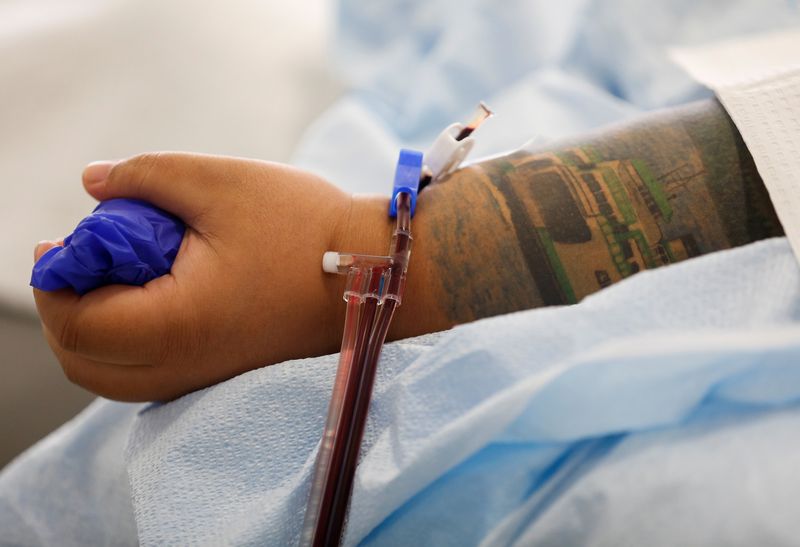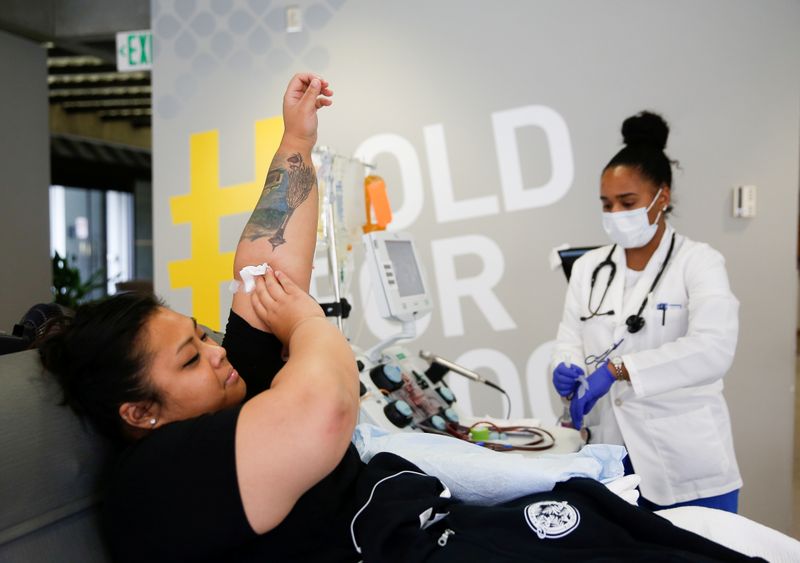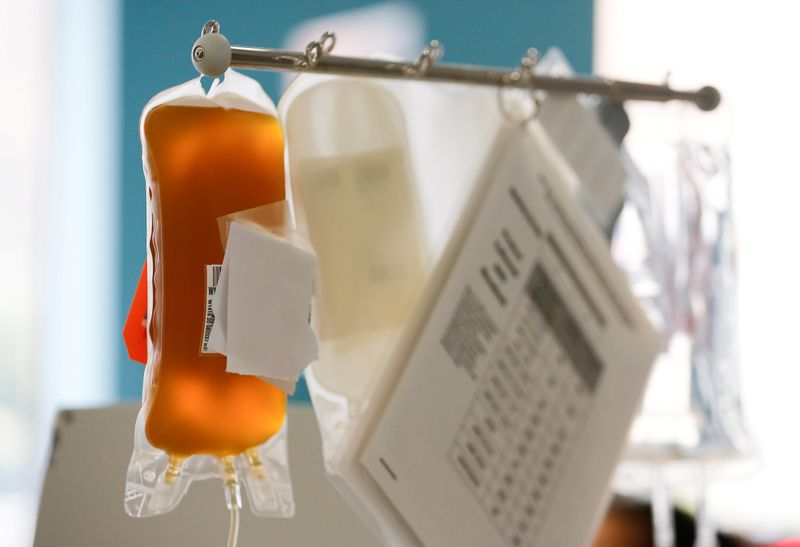August 14, (Reuters) – In late April, a coalition of New Mexico healthcare systems began asking local COVID-19 survivors to donate their plasma, the antibody-rich blood product used to help treat people hospitalized with the disease.
More than 50 people donated in May, but then the numbers starting falling, according to data from Vitalant, a nonprofit blood bank that works with the coalition to recruit donors. In June, 34 people gave plasma to the effort, the data show; in July it was just 29.
The coalition’s struggle is not unique. Across the United States, home to the world’s worst coronavirus outbreak, demand is soaring for COVID-19 convalescent plasma, known as CCP, to keep sick patients alive. But the number of willing donors isn’t keeping pace, according to interviews Reuters conducted with more than 25 regional hospitals, blood centers and other blood industry players across the country.
Many said they are having difficulty persuading survivors to give plasma, in part because it’s a time-consuming process. That has led to a patchy supply that, in some regions, doesn’t meet demand. It raises fears of CCP shortages ahead of an anticipated surge in infections in the fall.
The American Red Cross saw its CCP reserve fall more than 70% in July as it shipped plasma around the country faster than it could recruit new donations, said Chief Medical Officer Dr. Pampee Young.
The New York Blood Center, a regional blood bank with 19 donation centers in the New York area, said its plasma stock, built during the city’s COVID-19 spike in the spring, steadily dwindled in June and July as it sent supply to coronavirus hot spots like Texas and Florida.
Meanwhile, the U.S. government’s Biomedical Advanced Research and Development Authority (BARDA) told Reuters it has put on hold an earlier push to build a national reserve of CCP, acknowledging there isn’t enough supply for a surplus.
‘DONOR FATIGUE’
The people who spoke to Reuters cited several factors for the challenging climate.
It starts with the relatively limited pool of eligible donors. The United States has had more than 5.2 million confirmed coronavirus cases and 5 million survivors, but only a fraction meet the standards to give plasma.
A plasma donor must meet the same criteria as a blood donor, which include age, weight and health restrictions. Further winnowing the field, CCP donors must have tested positive for COVID-19 or its antibodies; many patients with suspected cases never recorded a positive test. They also must be symptom-free for 14 days before donating, per U.S. Food and Drug Administration guidelines.
“You have to go through 15 or 20 candidates to find a viable donor,” said Dr. Henry Wang, an emergency medicine doctor at Memorial Hermann Health System in Houston.
The result is that some blood centers ask the same volunteers to give over and over, leading to burnout.
“We are definitely seeing donor fatigue,” said Dr. Norbert Topf, chief quality medical officer at New Mexico-based Presbyterian Healthcare Services. “People get exhausted.”
The process centers on an IV needle that extracts blood, harvests its plasma, then returns red cells and platelets to the donor’s arm. Add in paperwork, health screenings and recovery time and visits can last nearly two hours, said Geoffrey Sorensen, a 33-year-old COVID-19 survivor and plasma donor.
And they can be emotional. Sorensen, of Huntington, New York, lost his grandmother to COVID-19 in March. He fought tears recalling how he spent each of his eight sessions mourning her.
Sorensen said he’s glad he gave, but added, “If you have a job, and you have a lot of other things to do, I can see where you might say,‘I went once,…I’m done.’”
Some blood centers said they may be losing potential donors to pharmaceutical companies, which pay premium prices for CCP, and use it to develop antibody-based drugs to battle the pandemic.
Japan’s Takeda Pharmaceutical Company Ltd., for example, is paying donors $200 for each of their first two CCP donations, before slotting them into regular new-donor rates that average about $75.
Nonprofit blood centers do not compensate for volunteer-based donations.
Sean Hemingway, Head of BioLife, Takeda‘s plasma collection arm, said Takeda is paying premiums “in respect of the urgency and importance of collecting” CCP. He said the company gives donors the option to give the money to charity.
AN IMPORTANT THERAPY
Plasma is the element of blood that carries water, enzymes and blood cells throughout the body. It also carries the antibodies humans form to fight off disease and boost immunity.
With no coronavirus vaccine or cure yet available, infusing sick patients with plasma containing COVID-19 antibodies has emerged as an important therapy.
Several studies have shown plasma infusions may reduce the risk of death for hospitalized patients. A preliminary analysis by the Mayo Clinic, which runs a program facilitating CCP treatment across the country, also found that use of plasma with higher levels of antibodies, earlier in treatment, reduces mortality as compared with patients treated later in the disease, with lower levels of antibodies.
Dozens of doctors interviewed by Reuters earlier this year reported improvements in patients who received plasma early in treatment. (https://reut.rs/3fZW2CR)
An estimated 150,000 doses of plasma have been given to U.S. patients.
BARDA, the federal biomedical authority, in June had requested that blood centers stockpile CCP in hopes of building a 400,000-unit national reserve. But it now realizes that may have to wait.
“Unless collections can be increased, it’s unlikely the country will be in a position to create an inventory,” said Elleen Kane, a spokeswoman for the U.S. Department of Health and Human Services, BARDA’s parent agency.
Long Island resident Diana Berrent, 46, who contracted COVID-19 in March, said she realized early-on the need to mobilize survivors like herself after she came across a blast email from New York’s Mount Sinai Hospital seeking plasma donations.
Berrent started the Facebook group Survivor Corps “to encourage every survivor to donate plasma as many times as they are allowed,” she said.
The Fight Is In Us, a campaign to promote CCP donation, backed by nonprofit blood centers and private-sector plasma collectors, uses celebrity sponsors like actor Dwayne “The Rock” Johnson, and has a website with a searchable listing of donation centers.
Blood banks say such efforts help. “We are definitely getting leads from their registrants,” said Dr. Susan Rossmann, chief medical officer at the Houston-based Gulf Coast Regional Blood Center.
GIFT CARDS AND RAFFLES
Still, banks are scrambling to coax donors.
In California, the Houchin Community Blood Bank is barely meeting demand for plasma, said Brad Bryan, chief executive officer of the Kern County-based facility. Kern has seen more new coronavirus cases in the last two weeks than any California county except Los Angeles. Houchin supplies hospitals in its area and around the country.
It has teamed up with local restaurants to woo donors with gift cards. Houchin is also giving away a daily $1,000 raffle split between two winners — not bad odds, given the modest donor pool, Bryan said.
Hoxworth Regional Blood Center, in Cincinnati, built up a sizable CCP reserve in the spring, when Ohio’s case totals were low. In June, as rising cases created more potential supply, donor traffic fell off, Chief Medical Officer Dr. David Oh said.
He reckons the decrease may have been due to plasma drifting out of the headlines lately, or the fact that, as people return to work, they have less free time to donate.
To compensate, Hoxworth has relaxed certain donor qualifications, expanded plasma donation hours and improved collection methods to harvest more plasma from each donation.
The good news: Hoxworth has seen a slight uptick in August donations, Oh said.
Other blood banks, too, said this month is looking brighter than last.
They include Arizona-based Vitalant, the nation’s second-largest nonprofit blood bank, with 125 donation centers nationwide. But spokesman Clifford Numark said the “emergency” remains.
“Some weeks, what we collect is a little more than we need, sometimes it’s somewhat less,” he said. “But it’s always very, very tight.”
(Reporting by Nick Brown in New York; additional reporting by Francesco Guarascio in Brussels; Editing by Michele Gershberg and Marla Dickerson)

























